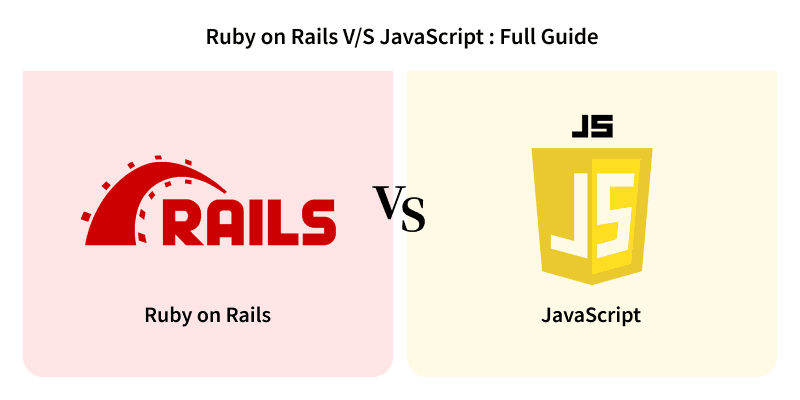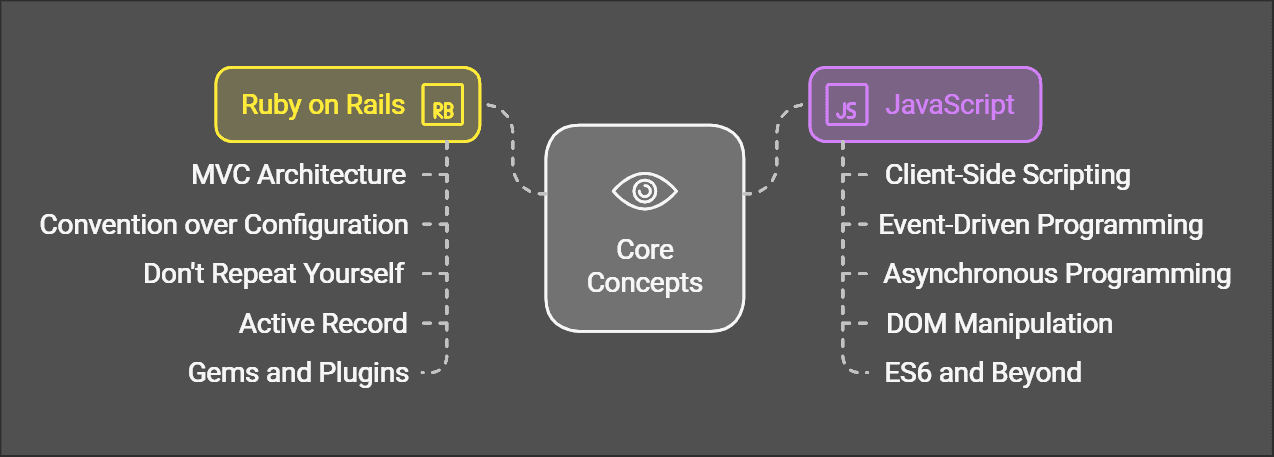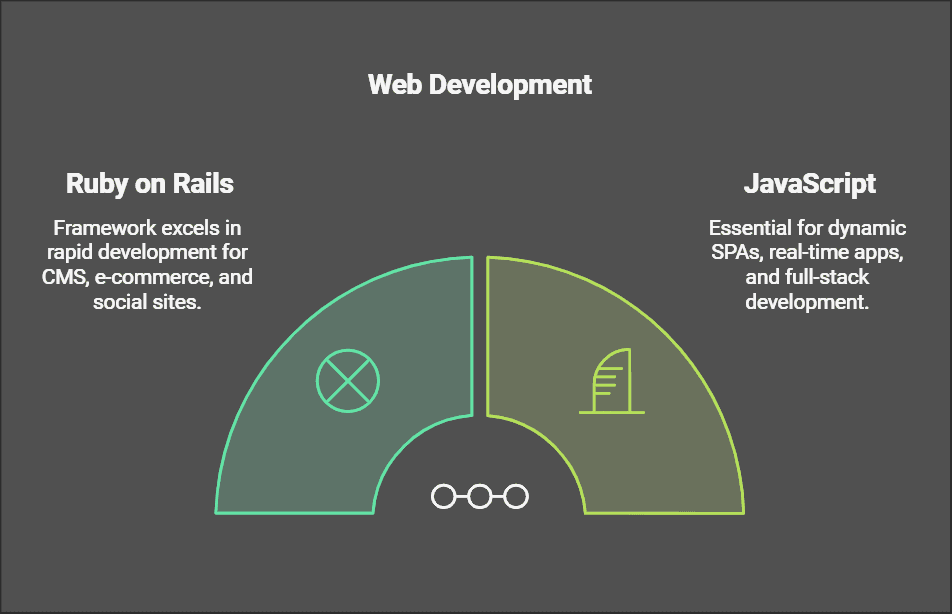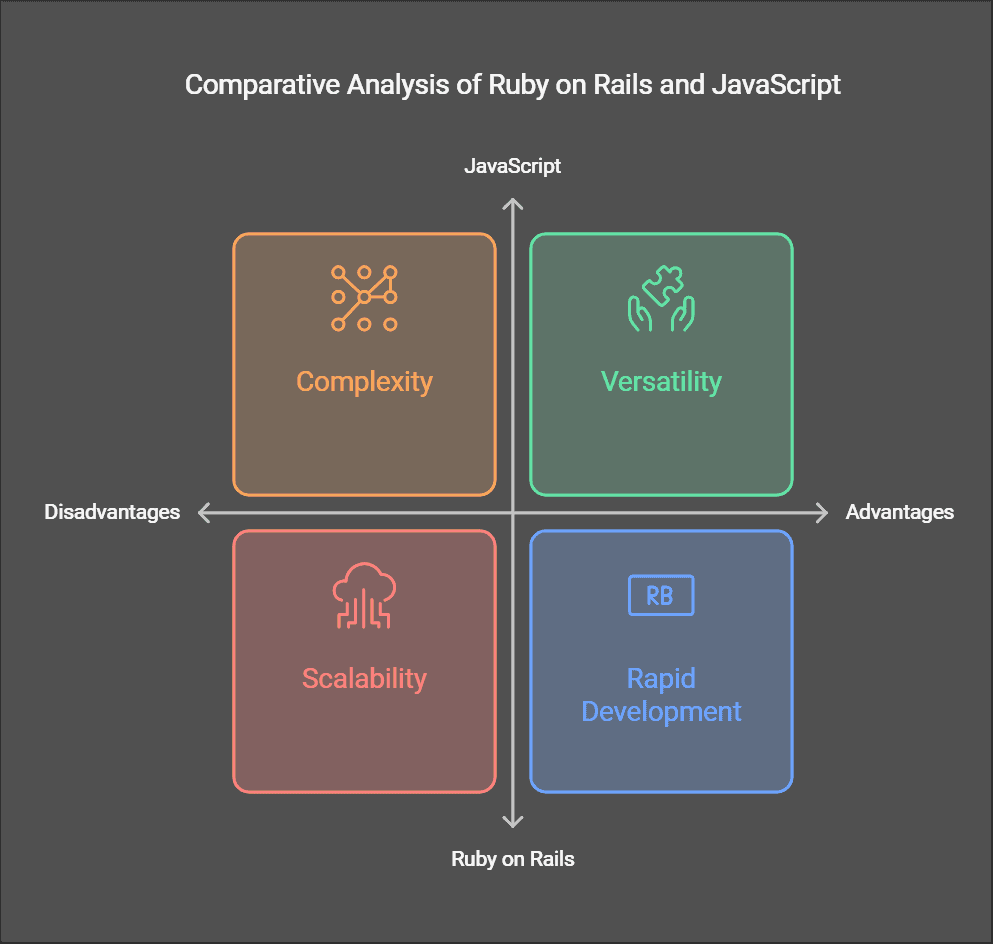Ruby on Rails V/S JavaScript: Full Guide

Introduction
Ruby on Rails (RoR) and JavaScript are two powerful tools for web development, each with unique strengths.
Ruby on Rails, a server-side framework, is celebrated for its simplicity and adherence to Convention over Configuration (CoC) and Don't Repeat Yourself (DRY) principles. JavaScript, essential for web interactivity, can be used both on the client side and server side with Node.js.
Ruby on Rails: Simplifies web application development by reducing code and emphasizing conventions.
JavaScript: Powers dynamic web pages and can handle both client-side and server-side tasks.
In this guide, we'll explore the key differences between Ruby on Rails and JavaScript to help you decide which is best for your next project.
Core Concepts

Fundamentals of Ruby on Rails
MVC Architecture: Ruby on Rails uses the Model-View-Controller (MVC) framework, which separates the application into three interconnected components:
Model: Manages the data and business logic.
View: Handles the presentation and user interface.
Controller: Connects models and views, processing user inputs and updating the model and view accordingly.
Convention over Configuration (CoC): Rails emphasizes conventions, reducing the need for configuration files and simplifying the development process.
Don't Repeat Yourself (DRY): This principle ensures that information is not duplicated. Every piece of knowledge has a single, unambiguous place within a system.
Active Record: An object-relational mapping (ORM) layer in Rails, enabling developers to interact with the database using Ruby code instead of SQL.
Gems and Plugins: Ruby on Rails has a rich ecosystem of libraries and plugins called gems, which extend the framework's functionality.
Fundamentals of JavaScript
Client-Side Scripting: JavaScript runs in the browser, enabling interactive web pages. It is essential for tasks like form validation, dynamic content updates, and user interface enhancements.
Event-Driven Programming: JavaScript handles events such as clicks, mouse movements, and keyboard inputs to create responsive and interactive experiences.
Asynchronous Programming: Using techniques like callbacks, promises, and async/await, JavaScript can perform non-blocking operations, which is crucial for web applications that require real-time updates.
DOM Manipulation: JavaScript can interact with the Document Object Model (DOM) to dynamically change the content, structure, and style of web pages.
ES6 and Beyond: Modern JavaScript includes features like arrow functions, classes, template literals, and modules, which enhance the language's capabilities and make the code more maintainable.
Use Cases

Typical Applications of Ruby on Rails
Content Management Systems (CMS): Rails is ideal for building CMS platforms due to its ease of use and rapid development capabilities. Examples include platforms like Shopify and RefineryCMS.
E-commerce Applications: With its strong database support and efficient handling of complex logic, Rails is used to develop robust e-commerce sites like Basecamp and Spree Commerce.
Social Networking Sites: Rails can quickly scale social networking sites, making it a suitable choice for sites like Twitter (initially built on RoR).
API Backends: Rails' built-in support for creating RESTful APIs makes it a preferred choice for developing backend services for mobile and web applications.
Prototyping and MVPs: Due to its rapid development cycle, Rails is excellent for building Minimum Viable Products (MVPs) and prototypes, allowing startups to get their products to market quickly.
Typical Applications of JavaScript
Single Page Applications (SPAs): JavaScript frameworks like Angular, React, and Vue.js are used to build SPAs, offering dynamic user experiences similar to desktop applications.
Real-time Applications: Node.js and libraries like Socket.io enable the development of real-time applications such as chat apps, gaming, and collaborative tools.
Front-end Development: JavaScript is essential for creating interactive and responsive web interfaces, from simple form validation to complex animations.
Full-Stack Development: With the advent of Node.js, JavaScript can be used for both server-side and client-side development, enabling the creation of full-stack applications using a single language.
Progressive Web Apps (PWAs): JavaScript plays a critical role in developing PWAs, which provide a native app-like experience on the web and can work offline.
These use cases highlight the versatility and strengths of Ruby on Rails and JavaScript in different areas of web development.
Performance and Scalability
Speed, Efficiency, and Scalability in Ruby on Rails
Speed: Ruby on Rails is known for its rapid development speed, thanks to its convention over configuration approach and extensive libraries (gems). This allows developers to quickly build and deploy applications.
Efficiency: The framework's use of DRY principles ensures that code is clean and maintainable, which improves efficiency in development and long-term maintenance.
Scalability: Rails can handle scalability with proper architecture and optimization techniques. However, it may face performance bottlenecks with very high traffic loads. Tools like caching, background job processing, and horizontal scaling can mitigate these issues.
Speed, Efficiency, and Scalability in JavaScript
Speed: JavaScript, particularly with Node.js, offers high performance due to its non-blocking, event-driven architecture. This allows it to handle a large number of concurrent connections efficiently.
Efficiency: JavaScript's asynchronous nature and extensive ecosystem of libraries and frameworks enable developers to write efficient, scalable code for both front-end and back-end development.
Scalability: JavaScript, especially with modern frameworks and libraries, is highly scalable. Technologies like microservices, serverless architectures, and containerization (using Docker) enhance its ability to scale efficiently across distributed systems.
Both Ruby on Rails and JavaScript have their strengths in performance and scalability, and the choice depends on the specific requirements of your project and your team's expertise
Ecosystem and Community
Libraries, Tools, and Community Support for Ruby on Rails
Libraries and Gems: Ruby on Rails boasts a rich ecosystem of libraries and plugins, known as gems. These gems extend the functionality of Rails, covering a wide range of needs such as authentication (Devise), background jobs (Sidekiq), and testing (RSpec).
Development Tools: Rails provides powerful development tools like Rails Console, Rails Server, and generators that streamline the development process. These tools help automate repetitive tasks and maintain a clean codebase.
Community Support: Ruby on Rails has a strong, active community that contributes to its growth and development. The community is known for its welcoming nature and extensive documentation, which makes it easier for newcomers to get started. There are numerous conferences, meetups, and online forums where developers can seek help and share knowledge.
Libraries, Tools, and Community Support for JavaScript
Libraries and Frameworks: JavaScript has an extensive ecosystem of libraries and frameworks. Popular ones include React, Angular, and Vue.js for front-end development, and Node.js and Express for server-side development. These tools provide powerful features and streamline the development process.
Development Tools: JavaScript development is supported by a wide range of tools such as npm (Node Package Manager), Webpack, Babel, and ESLint. These tools help manage dependencies, transpile modern JavaScript syntax, and ensure code quality.
Community Support: JavaScript has one of the largest and most active developer communities in the world. The community contributes to numerous open-source projects, ensuring continuous improvement and innovation. Developers can find support through online forums, Stack Overflow, GitHub, and various JavaScript conferences and meetups.
Pros and Cons

Advantages and Disadvantages of Ruby on Rails
Advantages:
Rapid Development: Ruby on Rails allows for quick prototyping and development, making it ideal for startups and MVPs.
Convention over Configuration: Reduces the need for configuration files, streamlining the development process.
Strong Community: A supportive and active community provides extensive documentation, gems, and tools.
Clean Code: Emphasis on DRY principles ensures clean, maintainable code.
Built-in Testing: Rails comes with built-in testing frameworks, promoting test-driven development.
Disadvantages:
Performance: While suitable for many applications, Rails may struggle with high-performance requirements compared to lower-level languages.
Scalability: Requires careful planning and optimization to scale effectively for large applications.
Learning Curve: For those new to Rails or Ruby, there can be a steep learning curve.
Flexibility: Conventions can sometimes limit flexibility, making customization more challenging.
Advantages and Disadvantages of JavaScript
Advantages:
Versatility: Can be used for both front-end and back-end development, offering a unified development experience.
Performance: Especially with Node.js, JavaScript offers high performance and handles asynchronous operations well.
Large Ecosystem: An extensive range of libraries, frameworks, and tools supports diverse development needs.
Active Community: One of the largest and most active developer communities, contributing to continuous innovation and support.
Real-time Applications: Excellent for building real-time applications such as chat apps and gaming.
Disadvantages:
Complexity: The flexibility and vast ecosystem can lead to complexity and decision fatigue when choosing the right tools and frameworks.
Security: JavaScript's ubiquity can make it a target for security vulnerabilities, requiring diligent security practices.
Browser Compatibility: Variations in browser implementations can cause inconsistencies and require additional handling.
Performance Overhead: Although fast, JavaScript's performance can be affected by heavy computation tasks, requiring optimization or offloading to other languages.
These pros and cons provide a balanced view of Ruby on Rails and JavaScript, helping you weigh their strengths and limitations for your specific project needs.
Job Market and Career Opportunities
Career Prospects with Ruby on Rails
Demand in Startups: Ruby on Rails is popular among startups due to its rapid development capabilities. This creates numerous job opportunities in young, dynamic companies looking for fast prototyping and MVP development.
Niche Expertise: Rails developers are often highly valued for their specialized skills. There is a steady demand for experienced developers to maintain and scale existing Rails applications.
Remote Work: Many Rails positions offer the flexibility of remote work, as the framework is widely adopted for web application development by distributed teams.
Community and Networking: Active participation in the Rails community through conferences, meetups, and online forums can open up job opportunities and career advancements.
Career Prospects with JavaScript
Wide Range of Opportunities: JavaScript's versatility creates a broad range of job opportunities, from front-end and back-end development to full-stack roles. The demand for JavaScript developers spans various industries, including tech, finance, healthcare, and e-commerce.
High Demand for Frameworks: Knowledge of popular JavaScript frameworks like React, Angular, and Vue.js increases job prospects. These frameworks are in high demand for building modern, interactive web applications.
Constant Growth: The JavaScript ecosystem is continuously evolving, and there is a high demand for developers who stay updated with the latest trends and technologies, such as serverless architecture and Progressive Web Apps (PWAs).
Global Opportunities: JavaScript is a universal language for web development, offering job opportunities worldwide. Many companies seek skilled JavaScript developers, often offering competitive salaries and benefits.
Community Involvement: Engaging with the extensive JavaScript community through open-source contributions, hackathons, and conferences can significantly enhance your career prospects and professional network.
FAQs
Common Questions About Ruby on Rails
What is Ruby on Rails? Ruby on Rails, often referred to as Rails, is a server-side web application framework written in Ruby. It emphasizes convention over configuration and the principles of DRY (Don't Repeat Yourself).
Why choose Ruby on Rails over other frameworks? Rails allows for rapid development and has a rich ecosystem of libraries (gems), which makes it an excellent choice for startups and MVPs.
Common Questions About JavaScript
What is JavaScript? JavaScript is a high-level programming language used for creating interactive and dynamic web pages. It can run on both the client side (in the browser) and the server side (with Node.js).
Why is JavaScript essential in web development? JavaScript adds interactivity and dynamic content to web pages, making it a fundamental part of modern web development.
Comparing Ruby on Rails and JavaScript
Which is better for rapid development: Ruby on Rails or JavaScript? Ruby on Rails is often preferred for rapid development due to its convention over configuration approach and extensive libraries that streamline the development process. JavaScript, with modern frameworks like React and Node.js, also supports fast development but may require more initial setup and configuration.
Is Ruby on Rails or JavaScript better for scalability? Both have their strengths: Rails can scale with the right optimization and architecture, while JavaScript, especially with Node.js, is known for handling concurrent connections efficiently and scaling well with modern web architectures.
Conclusion
Ruby on Rails and JavaScript each have their unique strengths and ideal use cases.
Ruby on Rails: Best for rapid development and strong conventions, making it suitable for startups and complex web applications.
JavaScript: Versatile and high-performing, great for both front-end and back-end development, essential for interactive web pages.
Choose based on your project's needs and your team's expertise to ensure the best results. Both technologies can lead to successful web applications when used appropriately.
